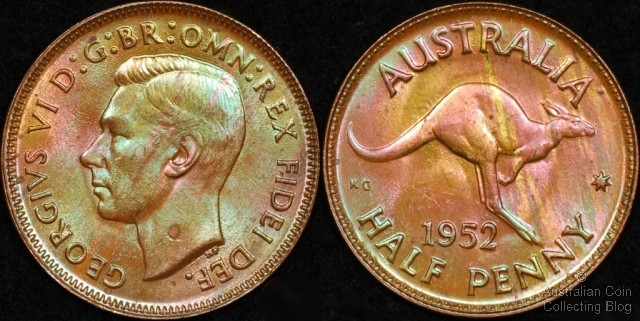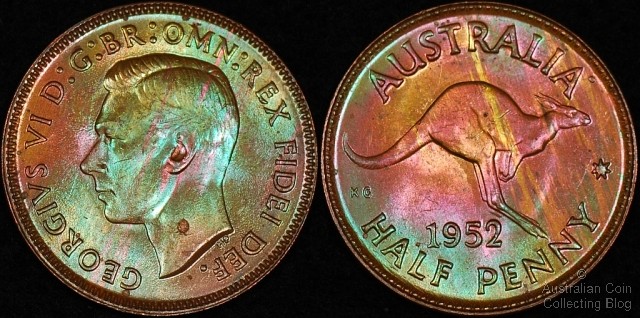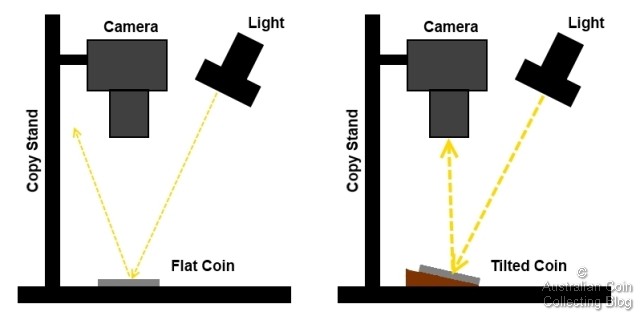
Image 1 : Australia 1952A Half Penny
Above you can see a lovely, glossy, lustrous Australian 1952 Half Penny. It's probably the most wildly toned bronze coin we've seen, and completely natural and typical of Perth minted bronze Australian coins. However, the image above doesn't do much to convey just how deep and wild the colours on this coin are. The image below gives a much better idea.

Image 2: Australia 1952A Half Penny
Believe it or not, the differences in setup between these two images were slight indeed. Yet the characteristics of the two images are completely different and the aspects of the coin character they convey are completely different. Firstly let's look at the difference in the actual physical setup used in the two images. This is shown in the (rather poor) image below.

Normal Coin Imaging and Tilted Coin Imaging
As you can see, the only real visible difference between the setup used to take the two images is that the coin in the second image has been tilted to reflect the light directly into the camera lens. This is different from the normal imaging setup where a more diffused reflected light is picked up by the camera lens. While the differences in setup are small, there are changes required to the camera to enable it to take both images properly. By the way if you wanted to see the actual equipment we use to take our images rather than the cartoonish representation above you should take a a look at this entry on how we take our coin photos.
Horizontal Coin Images require a large amount of light because of the diffused reflection to the camera lens. If you do not have enough light then you'll need a long exposure time and will likely lose some sharpness in your image. So the more light you have the better. Image 1 was taken with the camera at f10 and with a shutter speed of 1/200th of a second.
Tilted Coin Images need to be taken at a high f stop. This is because the coin is tilted and a larger depth of field is required around the focal plane to ensure the whole coin is in focus. The higher f stop allows this. Higher f stops require longer exposures than lower f stops and thus a lot of light is needed again. However this is counteracted by the brightness of the light reflected from the coin and usually exposure times are less for tilted coin images compared with horizontal coin images. Image 2 was taken with the camera at f13 and with a shutter speed of 1/320th of a second. There is one additional aspect to the physical setup that may be required with tilted coin images. Often the very act of reflecting light directly from the coin surface into the barrel of your camera can cause glare across an area of the coin. The remedy to this is to diffuse the light from your light sources using some sort of diffusion screen.
The Characteristics of Horizontal Coin Images vs Tilted Coin Images
| Characteristic | Horizontal Coin | Tilted Coin |
| Light | More | Less |
| f Stop | Lower f Stop | Higher f Stop |
| Exposure Speed | Slower | Faster |
| Coin Lustre | Realistic | Subdued |
| Colour | Subdued | Exaggerated |
| Image Contrast | Subdued | Exaggerated |
| Bag Marks | Subdued | Exaggerated and strongly contrasted |
When to Use the Tilted Coin Technique
In our experience the tilted coin technique can be useful for imaging certain types of coins. We'd suggest that using it on the following types of coins can be an effective method of conveying the true character of a coin:
- Colourfully toned glossy copper or bronze
- Proof coins with mirrored fields, especially those with toned mirrors
- Some toned silver coins, but should be used with caution as it can remove the appearance of lustre
Using the tilted coin technique can be an effective method of showing the true colours of a toned coin right across the surface of the coin. When used in conjunction with what we'd call the 'normal' horizontal image of a coin it can help to convey the true nature of a coin. That being said, it can also produce exaggerated images with wild colours, subdued lustre, and what can appear to be severe bag marking. It should therefore be used with some degree of caution.
Posted by mnemtsas at May 5, 2011 7:29 PM
Subscribe to our Newsletter


